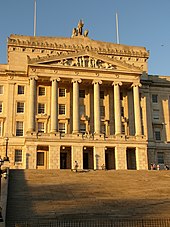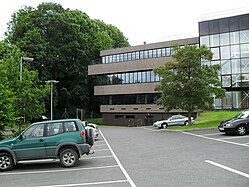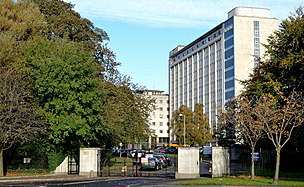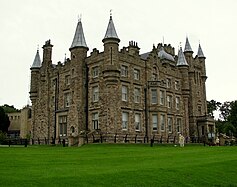Parliament Buildings (Northern Ireland)
| Parliament Buildings | |
|---|---|
| Stormont | |
 | |
| Location | Stormont Estate, Belfast |
| Coordinates | 54°36′18″N 5°49′56″W / 54.6050°N 5.8321°W |
| Built | 1932 |
| Architect | Sir Arnold Thornely |
| Architectural style(s) | Greek classical style |
Listed Building – Grade A | |
| Official name | Parliament building, walls & lamp standards |
| Designated | 13 March 1987 |
| Reference no. | HB26/13/013[1] |
Parliament Buildings, often referred to as Stormont, because of its location in the Stormont Estate area of Belfast, is the seat of the Northern Ireland Assembly, the devolved legislature for the region. The purpose-built building, designed by Arnold Thornely, and constructed by Stewart & Partners, was opened by Edward, Prince of Wales (later King Edward VIII), in 1932.
The Executive or government is located at Stormont Castle. In March 1987, the main Parliament Building became a Grade A Listed building.[1][2]
History
[edit]Original plans
[edit]
The need for a separate parliament building for Northern Ireland emerged with the creation of the Northern Ireland Home Rule region within Ulster in the Government of Ireland Act 1920. Pending the construction of the new building, the new Parliament of Northern Ireland met in two locations; one in Belfast City Hall, where the state opening of the first Parliament by King George V took place on 22 June 1921, and the other in the nearby Presbyterian Church in Ireland's Assembly's College.[3]
In 1922, a design by Sir Arnold Thornely of Liverpool was chosen and preparatory work on the chosen site, east of Belfast, began.[4] These plans were for a large domed building with two subsidiary side buildings, housing all three branches of government: legislative, executive and judicial, giving rise to the plural in the official title still used today.[5]
These plans were found to be too costly, and it was decided to build only the Parliament Building, without the dome. The foundation stone was laid on 19 May 1928.[4] It was designed in the neoclassical style, built by Stewart & Partners in ashlar stone and opened by Edward, Prince of Wales (later King Edward VIII), on 16 November 1932.[6]
Finished building
[edit]
After the shelving of plans to build a "Ministerial Building", the headquarters of government was in effect Stormont Castle, a baronial castellated house in the grounds and which was originally meant to have been demolished to make way for the "Ministerial Building". Stormont Castle served as the official residence of the Prime Minister of Northern Ireland and was the meeting place for the Northern Ireland Cabinet.[7] Another building, Stormont House, served as the official residence of the Speaker of the House of Commons of Northern Ireland.[8] The reduced plans saw the High Court eventually located in the newly built Royal Courts of Justice, Belfast in the city centre.[9]

Two separate chambers were provided in the finished parliamentary complex, the blue-benched rectangular House of Commons of Northern Ireland (green benches as at Westminster being considered inappropriate) and the red-benched smaller rectangular Senate of Northern Ireland. In the main hall, originally called the Central Hall but now known as the Great Hall, a large gold-plated chandelier was hung. It was a gift from King George V and had originally hung in Windsor Castle, where it had been a gift from German Emperor Wilhelm II. The Kaiser's chandelier had been removed from Windsor Castle and placed in storage during World War I. It was never hung in Windsor Castle again.[10]

The painting The Entry of King William into Ireland, a gift from the Dutch Government to its Northern Ireland counterpart, was hung in the House of Commons when it opened. However, it was removed after concerns that the painting also showed the Pope, who had blessed William's enterprise.[11]
The building itself changed little over the years, even as the parliaments meeting inside it did. To camouflage it during World War II, the building's Portland stone was painted with supposedly removable "paint" made of bitumen and cow manure. However, after the war, removing the paint proved an enormous difficulty, with the paint having scarred the stonework. It took seven years to remove the "paint", and the exterior façade has never regained its original white colour. While most traces of it were removed from the façades (though having done damage that can be seen up close), some of the remains of the paint survive in the inner courtyards and unseen parts of the building.[12]
Statues
[edit]Additional changes to the building and its environs include the erection of a statue to Edward, Lord Carson, in dramatic pose (on the drive leading up to the building) in 1932, a rare example of a statue to a person being erected before death, and the erection of a statue to Lord Craigavon in the Great Hall, halfway up the Imperial Staircase. Craigavon and his wife Viscountess Craigavon are buried in the estate grounds.[13]
Architectural fittings
[edit]Throughout the building, Robert Adams "Crown Victor" and "Sceptre Victor" floor springs were used to control the doors.[14]
Uses for the building
[edit]
The building was used for the Parliament of Northern Ireland until it was prorogued in 1972. The Senate chamber was used by the Royal Air Force (R.A.F.) as an operations room during World War II. The building was used for the short-lived Sunningdale power-sharing executive in 1974. Between 1973 and 1998, it served as the headquarters of the Northern Ireland Civil Service (N.I.C.S.). Between 1982 and 1986, it served as the seat of the rolling-devolution assembly.[15]
In the 1990s, Sinn Féin suggested that a new parliament building for Northern Ireland should be erected, saying that the building at Stormont was too controversial and too associated with unionist rule to be used by a power-sharing assembly. However, no one else supported the demand and the new Northern Ireland Assembly and executive was installed there as its permanent home.[16]
On 3 December 2005, the Great Hall was used for the funeral service of former Northern Ireland and Manchester United footballer George Best. The building was selected for the funeral as it is in the only grounds in Belfast suitable to accommodate the large number of members of the public who wished to attend the funeral. Approximately 25,000 people gathered in the grounds, with thousands more lining the cortege route.[17]
On 29 September 2012, the grounds were used for an Orange Order parade in memory of the signing of the Ulster Covenant. 60,000 people thronged the grounds after a parade through the streets of Belfast.[18]
Security breach
[edit]On 24 November 2006, Michael Stone (a loyalist paramilitary member) was arrested for breaking into Stormont with an imitation handgun and a knife, and scrawling graffiti on Parliament Buildings itself.[19] Initial news reports indicated that he may have been carrying a "suspect device". Later, between six and eight pipe bombs were defused by the Army.[19]
The chambers
[edit]Assembly Chamber
[edit]
The entire House of Commons chamber was destroyed by a fire on 2 January 1995, blamed on an electrical fault in the wiring below the Speaker's chair. Critics alleged arson and noted how the destruction of the chamber allowed the creation of the modern, less-confrontational chamber now used by the power-sharing Northern Ireland Assembly, which has no echo of the earlier seating arrangement. The British Government, citing the Doyle Report and the findings of the Northern Ireland forensic science laboratory, stated that it was "improbable" that the fire was deliberate.[20] The seating is arranged in a horseshoe arrangement.[21]
Senate
[edit]
Unlike the new Assembly chamber which replaced the old House of Commons chamber, the Senate chamber, with its red leather adversarial seats in two parallel blocks of benches, remains as it was originally designed. Irish damask linen hangs on the walls; plans to line the walls with large oil paintings fell through. The chamber has not been used as a parliamentary chamber in plenary session since the suspension of devolved government in 1972. The Senate chamber is now used as a committee room.[22]
There have been few changes made to the chamber since the building opened in 1932. One change is the installation of television cameras and microphones. Another is the addition of two paintings. One painting, which is untitled, depicts the state opening of the Northern Ireland Parliament in 1921. Facing this painting on the opposing wall is The House Shall Divide, a group portrait of the members elected to the inaugural Assembly in the 1998 Northern Ireland Assembly election.[22]
A further alteration that has been made to the chamber since 1932 is the addition of an inscription in the marble of the balustrade of the Senate Chambers Press Gallery. The message reads: "This inscription records the gratitude of His Majesty's Government in the United Kingdom for the use of this chamber as an operations room by the Royal Air Force during the Second World War."[22]
Stormont Estate
[edit]The Stormont Estate is the site of Northern Ireland's main government buildings, including the Parliament Buildings, Stormont Castle and Stormont House.
Stormont regulations
[edit]The regulations governing the use of the Stormont Estate are displayed at its entrance. These were initially enacted on 31 October 1933, in an order by the Ministry of Finance. These were eventually amended and the regulations currently in force are:
- The Stormont Estate Regulations, 1933
- The Stormont Estate Amendment Regulations (Northern Ireland), 1951
- The Stormont Estate Amendment Regulations (Northern Ireland), 1958
Gallery
[edit]-
Lord Craigavon's grave;
the eastern end of the Parliament Buildings are in the background
See also
[edit]- Scottish Parliament Building
- Senedd building
- Palace of Westminster
- City Hall, London (Newham)
- Leinster House
References
[edit]- ^ a b "Historic Building Details". Department for Communities. Archived from the original on 19 March 2018. Retrieved 18 March 2018.
- ^ "Parliament Buildings and Sustainability". Northern Ireland Assembly. Retrieved 7 July 2023.
- ^ "Programme for the opening of the Northern Ireland Parliament, 1921". Lisburn Museum. Retrieved 4 February 2022.
- ^ a b "Parliament Buildings". Parliament Buildings – A History. The Northern Ireland Assembly Commission. Archived from the original on 15 May 2018. Retrieved 1 January 2018.
- ^ "Parliament Buildings Facts". Northern Ireland Assembly. Northern Ireland Assembly Commission. Archived from the original on 1 January 2018. Retrieved 1 January 2018.
- ^ Hansard Archived 1 January 2018 at the Wayback Machine 15 November 1932
- ^ "Stormont Castle History and tour". Northern Ireland Executive. Archived from the original on 24 April 2011. Retrieved 2 March 2016.
- ^ Boothroyd, David. "The Northern Ireland Parliament". United Kingdom Election Results. Archived from the original on 9 September 2019. Retrieved 1 November 2019.
- ^ "Royal Courts of Justice, Belfast". NI Direct. 13 October 2015. Archived from the original on 1 November 2019. Retrieved 1 November 2019.
- ^ "Stormont opens its doors for free tours". News Letter. 5 July 2011. Archived from the original on 1 November 2019. Retrieved 1 November 2019.
- ^ Cochrane, Feargal (2013). Northern Ireland: The Reluctant Peace. Yale University Press. ISBN 978-0300178708.
- ^ "Parliament Buildings Facts". Northern Ireland Assembly. Archived from the original on 30 October 2019. Retrieved 1 November 2019.
- ^ "Lord Craigavon's silver donated to Ulster Museum". BBC News. 9 February 2011. Archived from the original on 1 November 2019. Retrieved 5 February 2024.
- ^ Surveyor. 1932.
- ^ "Devolution and the Northern Ireland Assembly, The Way Forward, Ulster Unionist Assembly Party's Report Committee (1984)". Ulster University. Archived from the original on 23 July 2019. Retrieved 1 November 2019.
- ^ "Stormont: Why does Northern Ireland not have a government?". BBC. 9 January 2019. Archived from the original on 1 November 2019. Retrieved 1 November 2019.
- ^ "Tens of thousands of mourners line the streets of Belfast as George Best's homeland bids farewell to the footballing legend". The Telegraph. 4 December 2005. Archived from the original on 1 November 2019. Retrieved 1 November 2019.
- ^ "Ulster Covenant: Thousands due at centenary parade". BBC. 29 September 2012. Archived from the original on 1 November 2019. Retrieved 1 November 2019.
- ^ a b "Stormont attack devices defused". BBC News. 24 November 2006.
- ^ Wynn Davies, Patricia (19 April 1995). "£1.5m Stormont blaze a catalogue of errors". The Independent. Archived from the original on 1 November 2019. Retrieved 7 February 2024.
- ^ Shaw, Sylvia (2020). Women, Language and Politics. Cambridge University Press. p. 98. ISBN 978-1-107-08088-1.
- ^ a b c "A guide to Parliament Buildings" (PDF). Northern Ireland Assembly. Archived (PDF) from the original on 1 April 2017. Retrieved 1 November 2019.
External links
[edit]- 1928 establishments in Northern Ireland
- 20th-century architecture in Northern Ireland
- Buildings and structures in Belfast
- Fires at legislative buildings
- Government buildings completed in 1932
- Government buildings in Northern Ireland
- Grade A listed buildings
- Legislative buildings in the United Kingdom
- Neoclassical architecture in Northern Ireland
- Parliament of Northern Ireland
- Politics of Belfast
- Seats of national legislatures










